1950s Fashion Dresses: 20 Iconic Looks That Defined a Timeless Era

The 1950s were all about polished silhouettes, romantic waistlines, and refined details. Dresses weren’t just clothing—they were a daily expression of grace, femininity, and optimism after the war years. Whether designed for homemaking or high society, the structured styles of the decade helped shape the blueprint for modern-day elegance.
1. Full-Skirted Tea Dress with Fitted Bodice
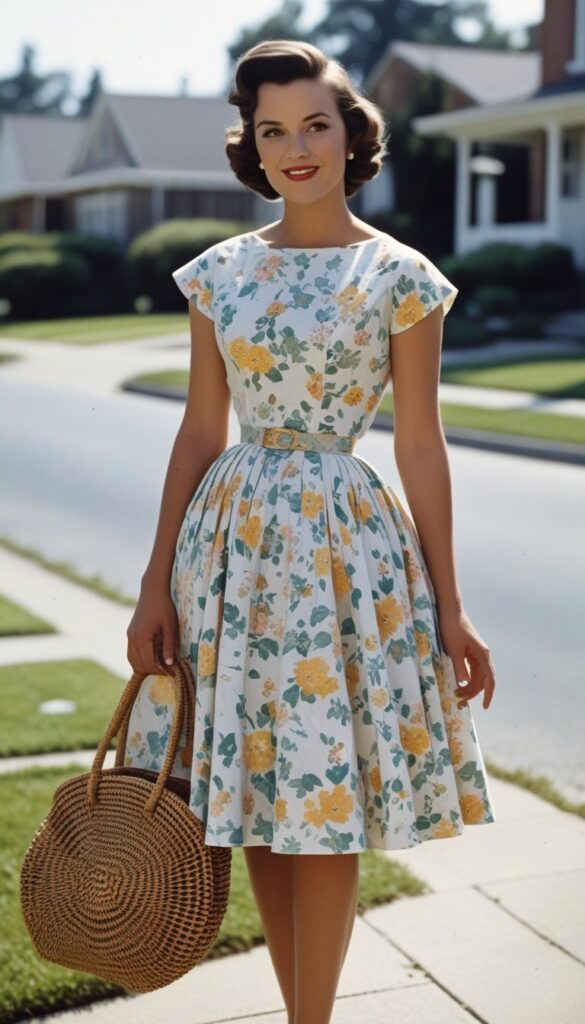
A staple of 1950s daywear, the tea dress featured a close-fitting top with a generous A-line or circle skirt. Often styled in florals, gingham, or polka dots, it struck the perfect balance between comfort and elegance. Worn with short gloves and modest heels, it became a go-to for garden parties and social lunches.
Why it works:
The cinched waist and full skirt enhance an hourglass shape, offering both movement and timeless femininity.
2. Halter Neck Polka Dot Dress
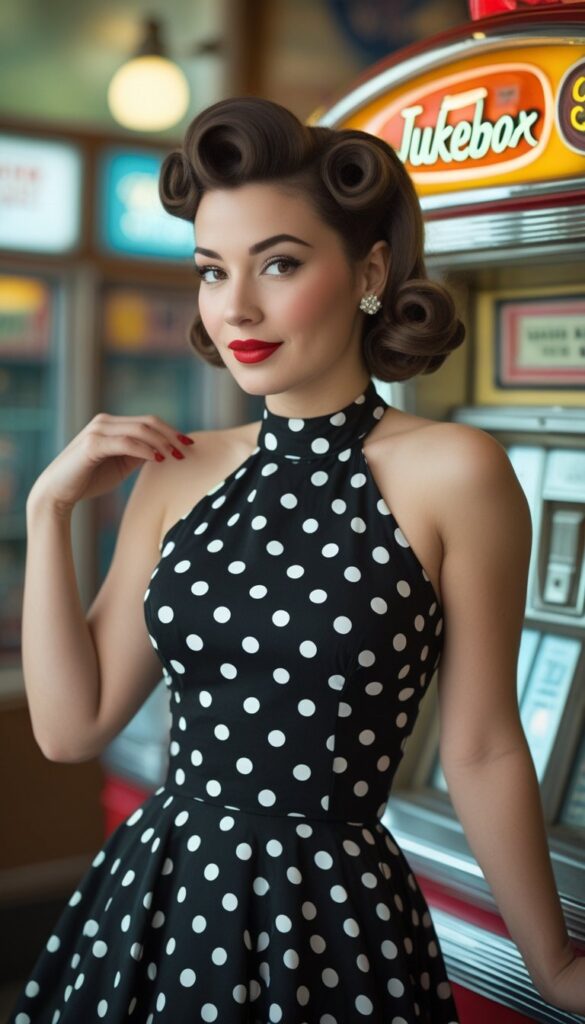
This flirty piece was a pin-up favorite. The halter neckline showcased the shoulders while the cinched waist and dramatic skirt added swing and flair. Bold polka dots were everywhere, exuding playful confidence and an unmistakable retro vibe.
Why it works:
The halter neckline elongates the neck and draws attention upward, while the silhouette flatters curves in a balanced way.
3. Shirtwaist Dress with Button Front
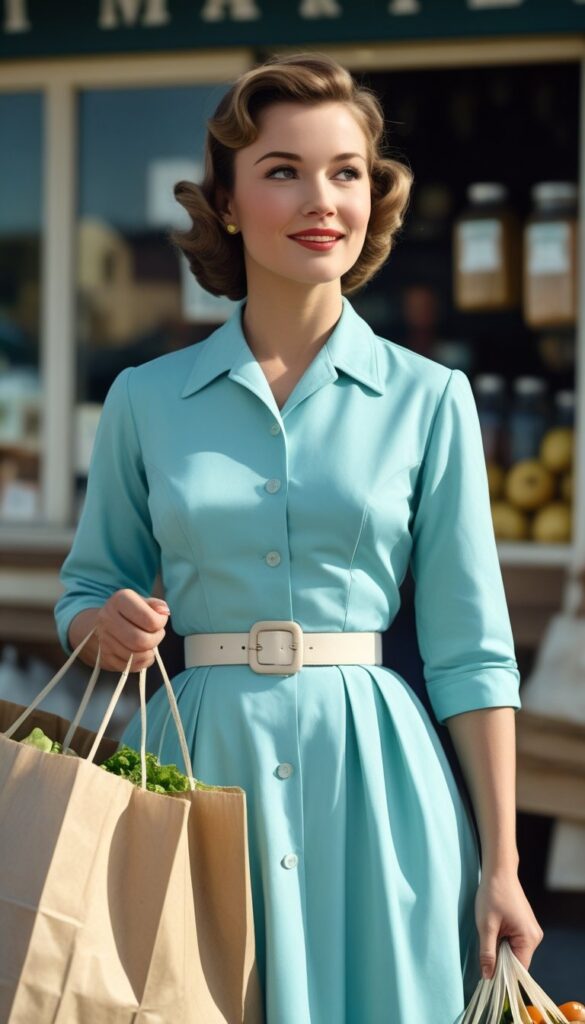
Practical and effortlessly stylish, this dress took cues from men’s shirts but added a feminine twist. With a button-down top, collar, and belted waist, it was ideal for homemakers and working women alike. Patterns ranged from soft plaids to solid pastels.
Why it works:
It blends structure with ease, giving a tailored look that’s comfortable for everyday wear while still appearing polished.
4. Off-Shoulder Satin Evening Gown
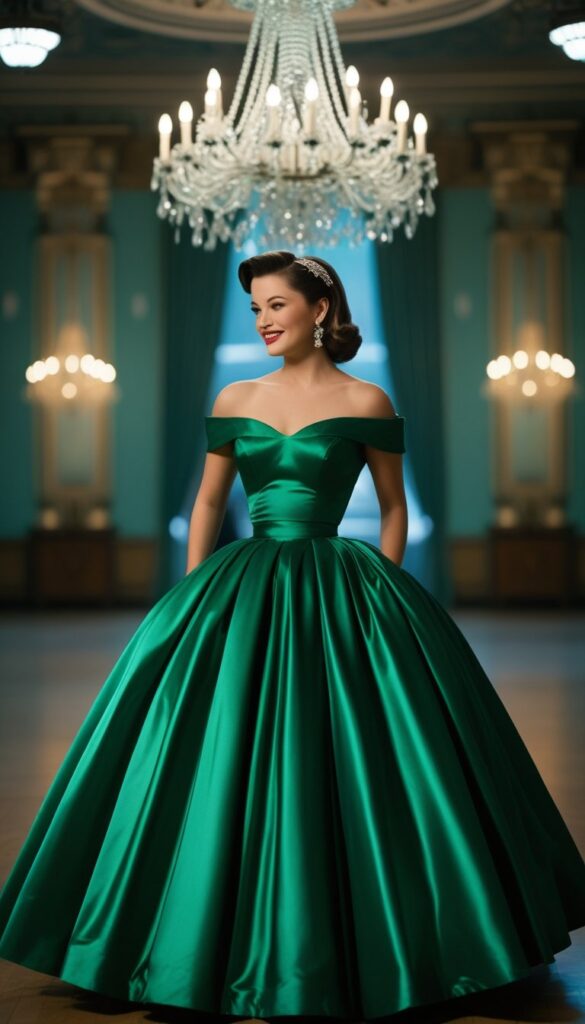
For formal events, off-shoulder gowns in satin or taffeta stole the show. These dresses had structured bodices and voluminous skirts, often worn with petticoats and pearls. Popular in rich jewel tones, they were designed for elegance and grandeur.
Why it works:
The off-shoulder cut frames the collarbones and adds drama, while the satin fabric creates a luxe, romantic silhouette.
5. Plaid Day Dress with Cap Sleeves

A casual yet stylish option, the plaid day dress was perfect for errands or casual outings. Featuring a fitted bodice, cap sleeves, and modest skirt length, it was usually styled with loafers or saddle shoes for a clean, everyday look.
Why it works:
Plaid brings a touch of classic patterning, while the shape remains flattering without feeling too formal.
6. Strapless Cocktail Dress with Tulle Overlay
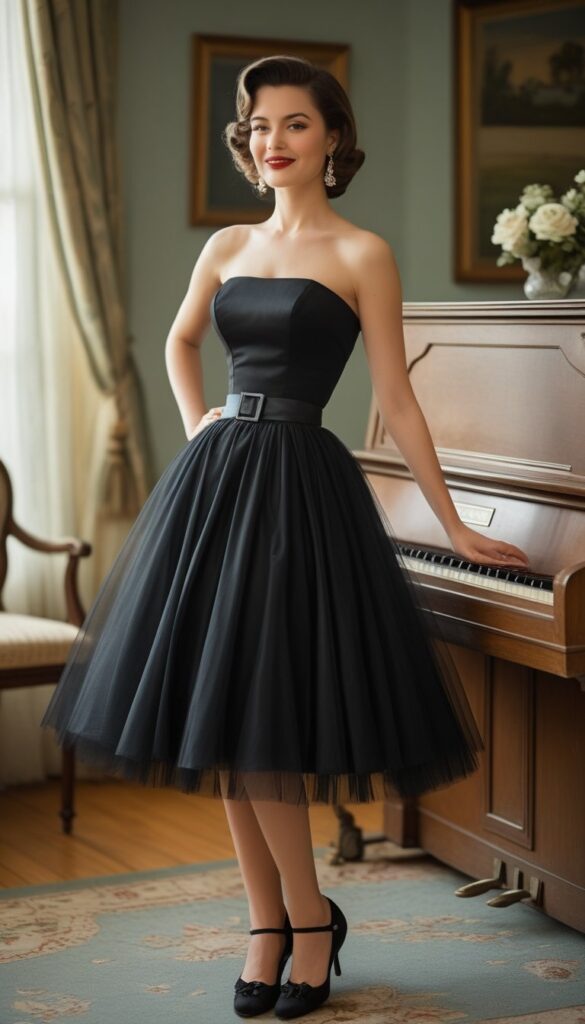
Designed for semi-formal events and parties, the strapless cocktail dress became iconic in the ’50s. It often featured boned bodices for support and layers of tulle or lace for volume and texture. These dresses highlighted the shoulders and collarbones, often accessorized with opera gloves or rhinestone earrings.
Why it works:
The strapless neckline adds a touch of glamour, while the structured shape ensures an elegant and confident silhouette.
7. Sleeveless Sheath Dress with Boat Neckline
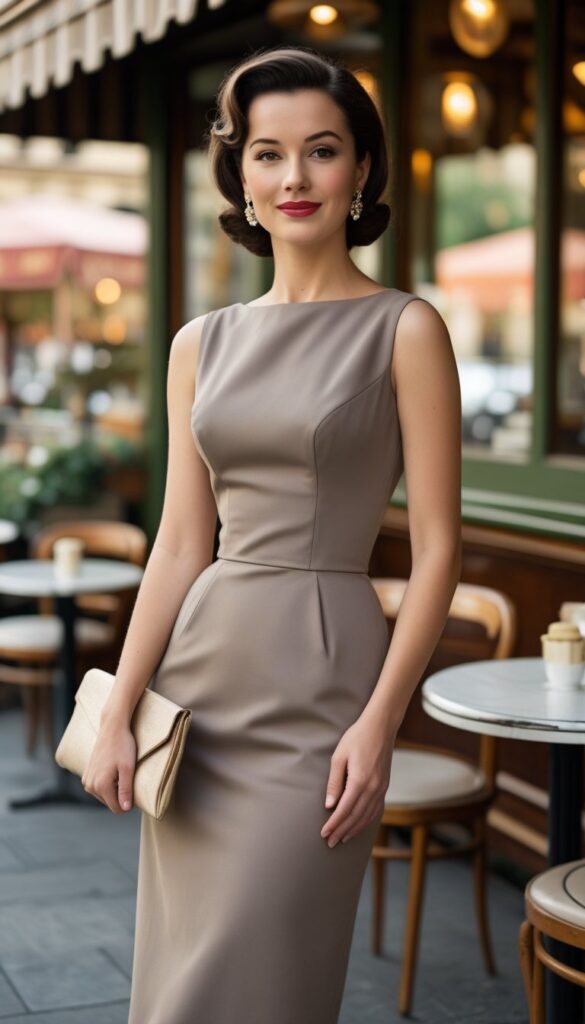
This sleek alternative to full skirts emphasized clean lines and minimalism. Popular with professional women and eveningwear alike, it was usually made of silk, wool, or satin. The boat neckline gave modest coverage while elongating the neck and shoulders.
Why it works:
The sheath silhouette hugs the body without being revealing, offering a confident, graceful profile perfect for day-to-night transitions.
8. Puff Sleeve Floral House Dress
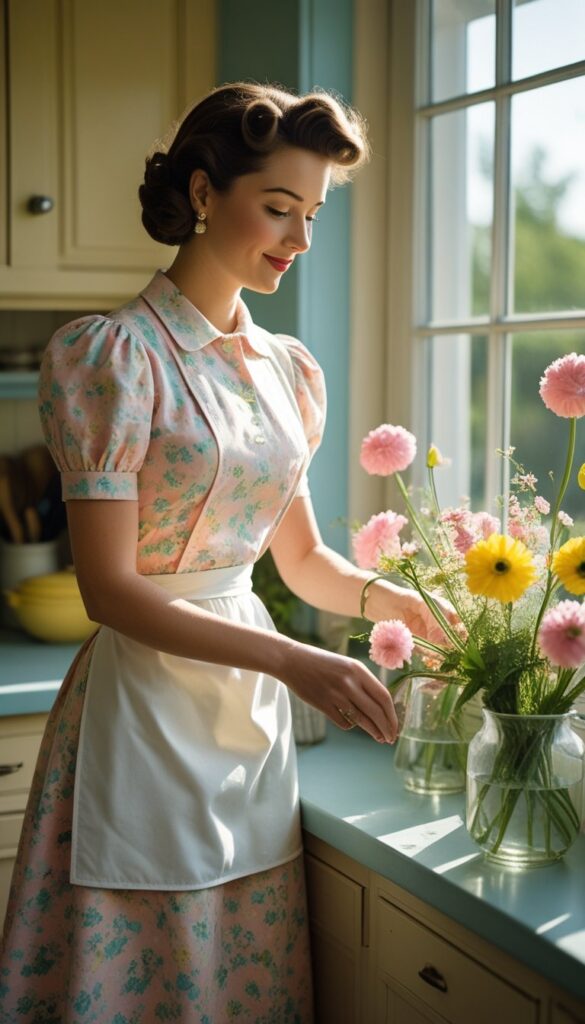
Worn primarily at home but still stylish, house dresses often had cheerful prints and puff sleeves for femininity. They featured functional buttons, patch pockets, and belted waists. These designs were simple but flattering, reflecting pride in presentation even in domestic settings.
Why it works:
It shows how everyday wear can still feel stylish and thoughtful, blending comfort with flattering structure.
Also Read:1950s Fashion: 17 Iconic Outfit Ideas That Capture the Era
9. Velvet Fit-and-Flare Dress with Sweetheart Neckline
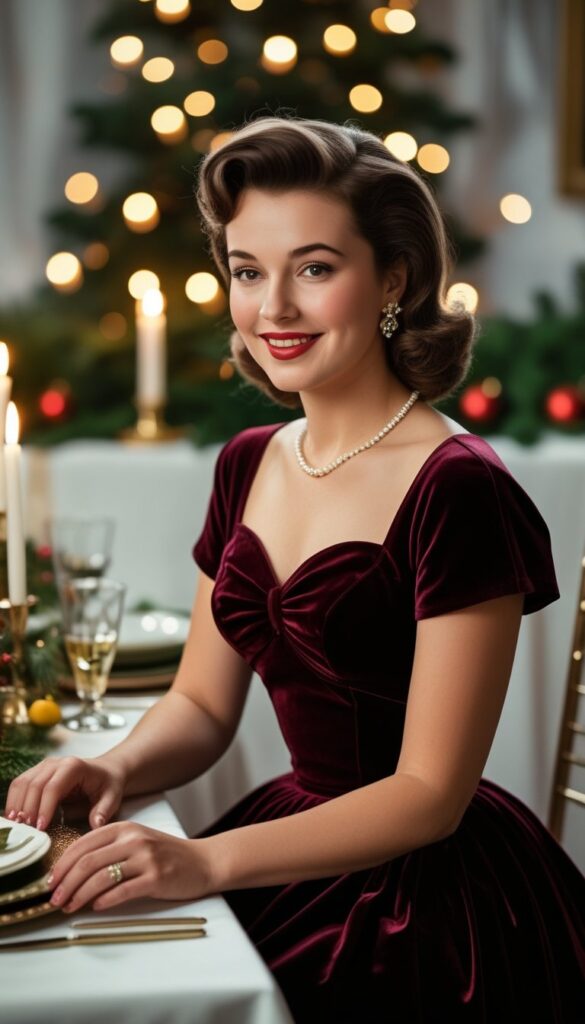
Velvet dresses were reserved for special occasions, exuding elegance through their rich texture. A sweetheart neckline offered a romantic feel, while the flared skirt added movement and classic proportion. Often styled with pearls and a clutch, this was a winter party staple.
Why it works:
The deep texture of velvet enhances richness, while the sweetheart neckline softens and romanticizes the overall shape.
10. Collared Polka Dot Swing Dress with Cinched Waist
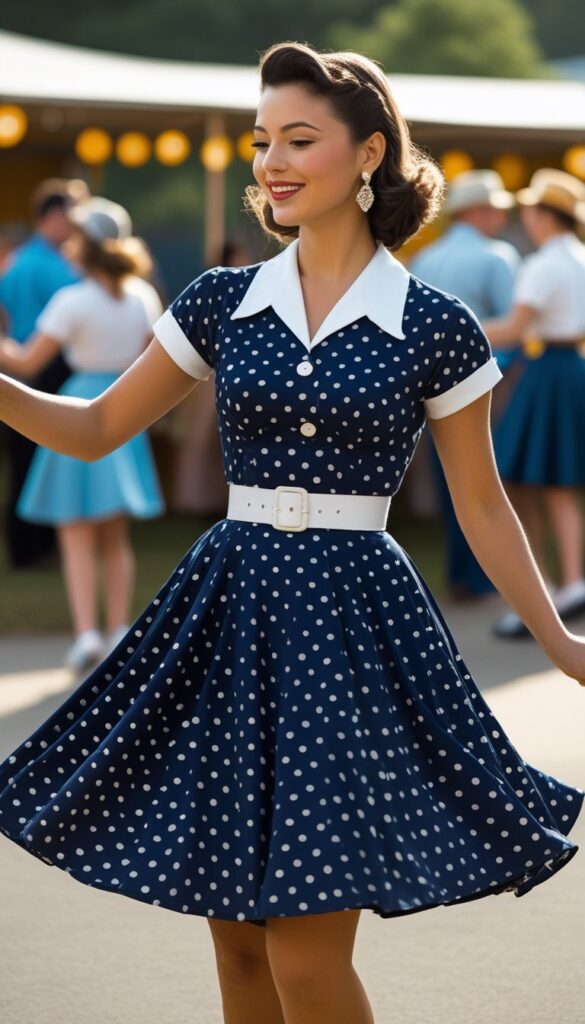
Fun and flirty, swing dresses with collars became popular through TV and film. The playful dot pattern added youthfulness, while the collared neck added refinement. The exaggerated skirt made it perfect for dancing or casual dates.
Why it works:
It captures 1950s charm by balancing modesty with movement and playful patterns, appealing to many age groups.
11. Shirtwaist Dress with Belted Waist
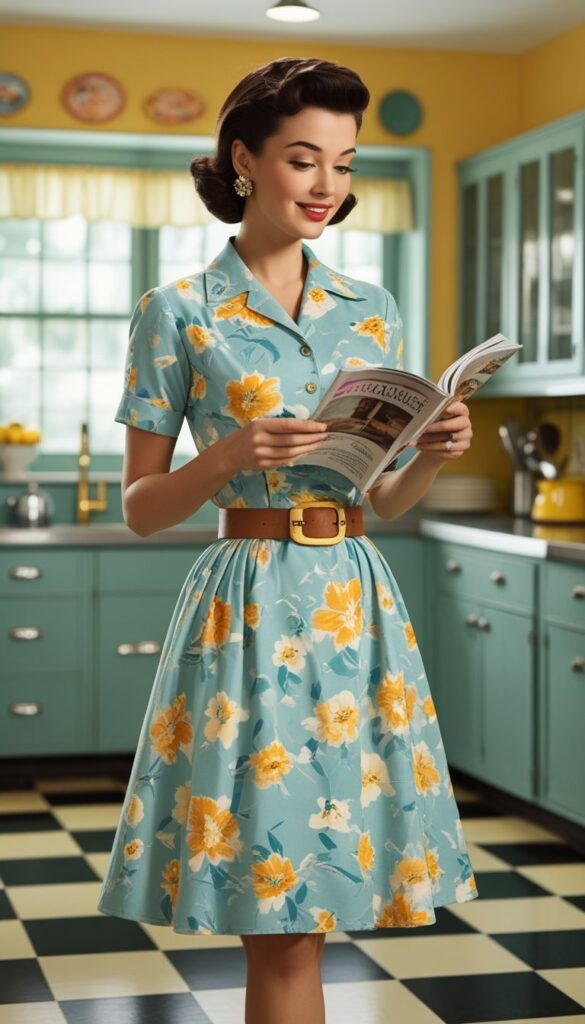
The shirtwaist dress borrowed tailoring from men’s shirts but softened it with feminine details like floral prints and full skirts. Button-down fronts and structured collars gave it a neat, composed look ideal for both casual outings and daily wear. A matching or contrasting belt emphasized the waistline.
Why it works:
It’s practical yet stylish, offering a balance between formality and comfort that defined the 1950s housewife aesthetic.
12. Off-Shoulder Satin Evening Gown
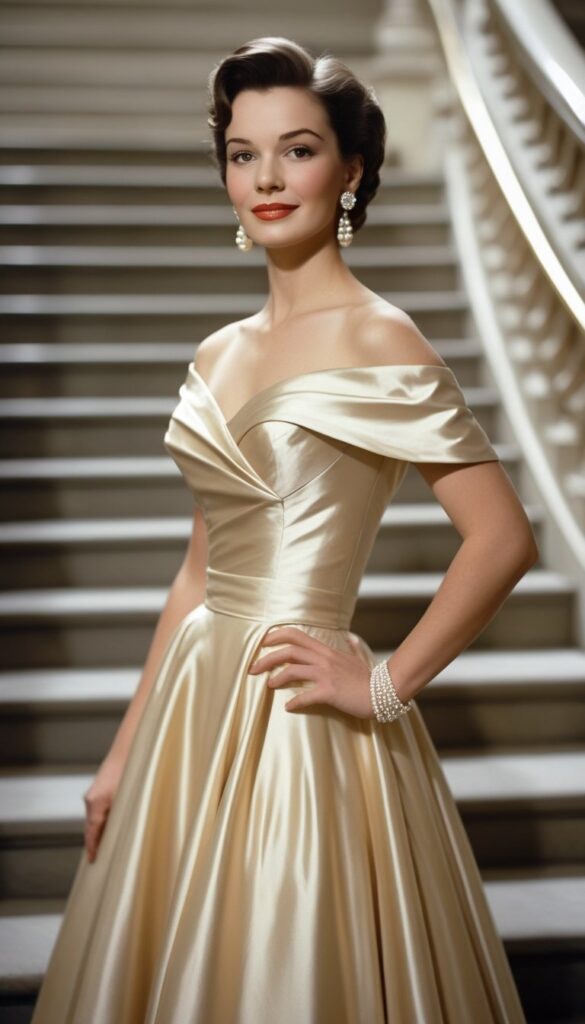
Off-shoulder satin gowns captured glamour with flowing lines and subtle sheen. Worn at formal dinners and charity galas, these dresses often featured dramatic draping and sweetheart bustlines. Paired with pinned-up hair and red lipstick, they radiated classic elegance.
Why it works:
It exudes timeless beauty, letting the shoulders and neckline create an elegant focal point while maintaining structured grace.
13. Checked Day Dress with Peter Pan Collar
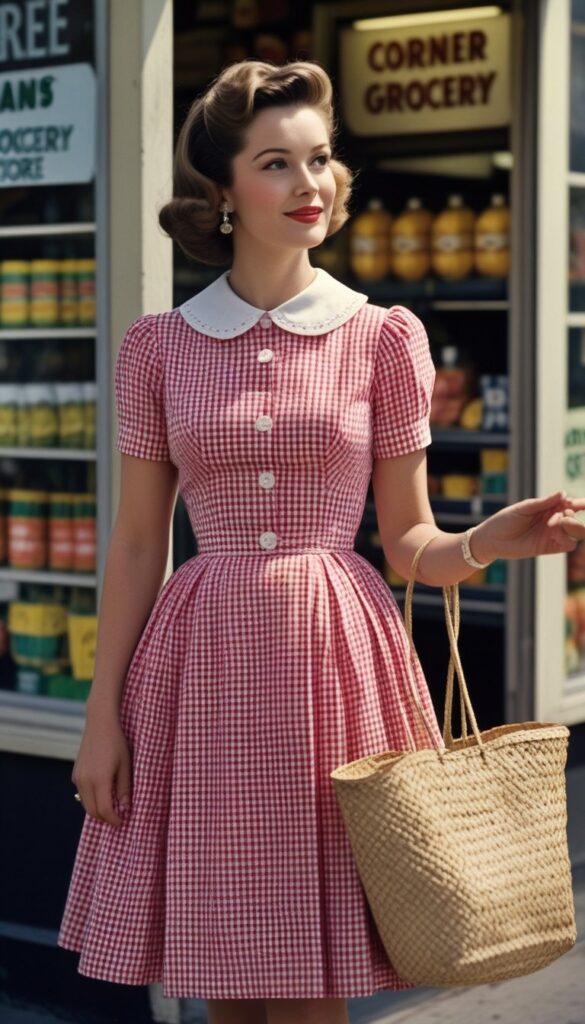
Checks and gingham prints were a daytime staple, especially in cotton fabrics. The Peter Pan collar added a youthful, modest touch, while short sleeves and pleated skirts gave it movement. These dresses were functional yet carried strong visual personality.
Why it works:
The playful print meets classic tailoring, making it nostalgic and wearable for casual vintage lovers.
14. Empire Waist Organza Dress with Puff Sleeves
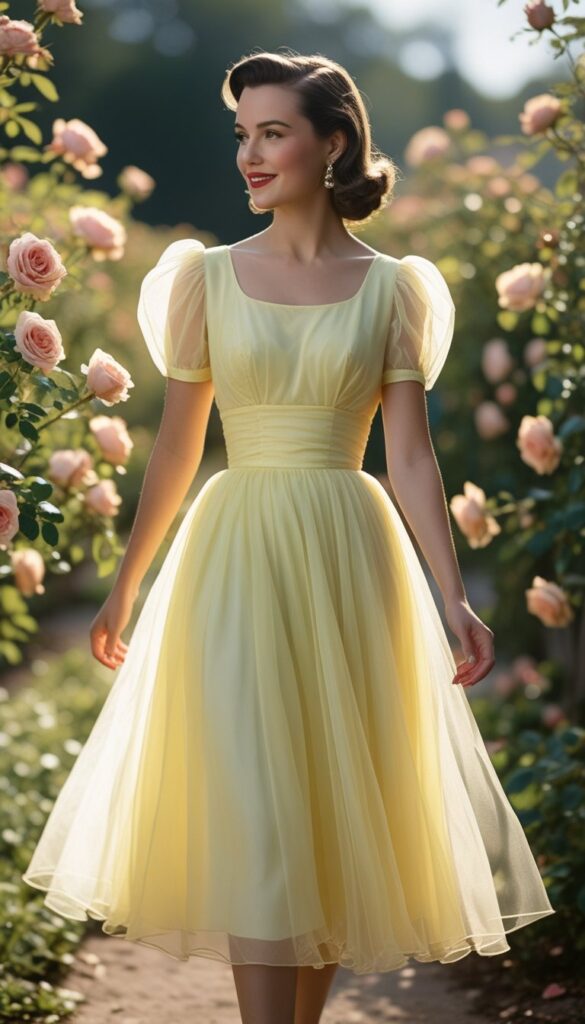
Lightweight and flowy, organza dresses with empire waists brought softness to the silhouette. Puff sleeves added a vintage charm, and pastel shades made them ideal for garden parties or Easter Sundays. These designs emphasized grace over structure.
Why it works:
Its romantic silhouette highlights femininity without being overly structured, evoking innocence and dreamy nostalgia.
Also Read:1950s Fashion Women: 18 Iconic Looks That Defined the Decade
15. Halter Neck Sundress with Full Skirt
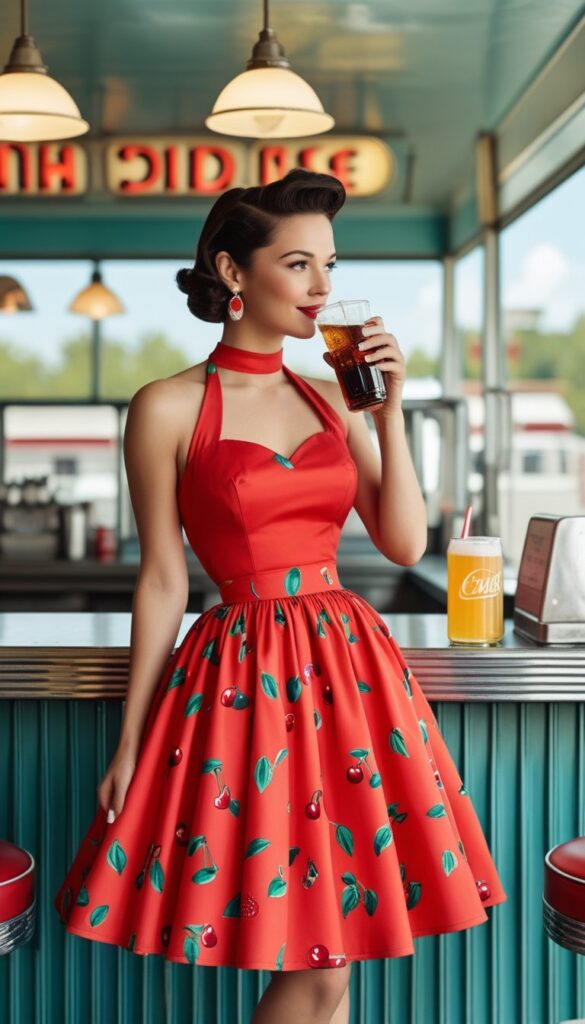
Perfect for summer, halter neck sundresses exposed the shoulders while keeping the overall look playful and covered. Bold patterns like cherries or palm leaves added flair, and the cinched waist with flared skirt stayed true to 1950s fashion codes.
Why it works:
It merges fun and flattery, allowing freedom of movement while enhancing curves through classic
16. Fit-and-Flare Dress with Polka Dots

The fit-and-flare silhouette defined the era, and polka dots added a playful flair. These dresses often came with cap sleeves and a wide cinched waistband to emphasize the hourglass figure. Paired with gloves and kitten heels, they embodied 1950s femininity.
Why it works:
The flattering shape and bold print make it both timeless and fun, offering a look that works for casual wear or semi-formal events.
17. Strapless Evening Dress with Tulle Overlay
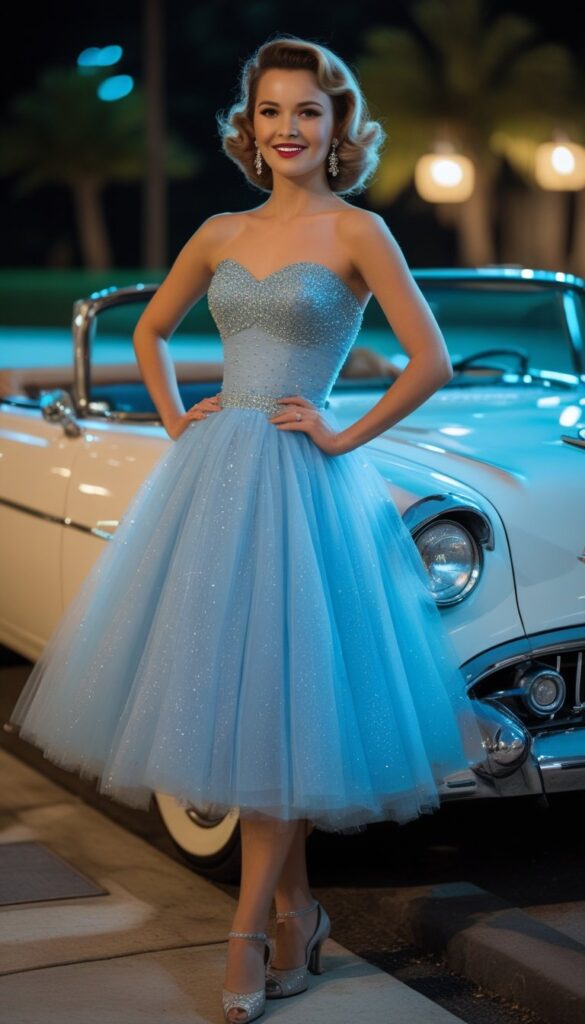
Strapless dresses became evening staples, especially those with layers of tulle that added volume and lightness. Often adorned with rhinestones or embroidery, they offered a blend of youthful charm and high-end glamour. A classic updo completed the look.
Why it works:
It celebrates drama and elegance, showing off the shoulders while using layered fabric to create depth and sophistication.
18. Day Dress with Pleated Skirt and Contrast Trim
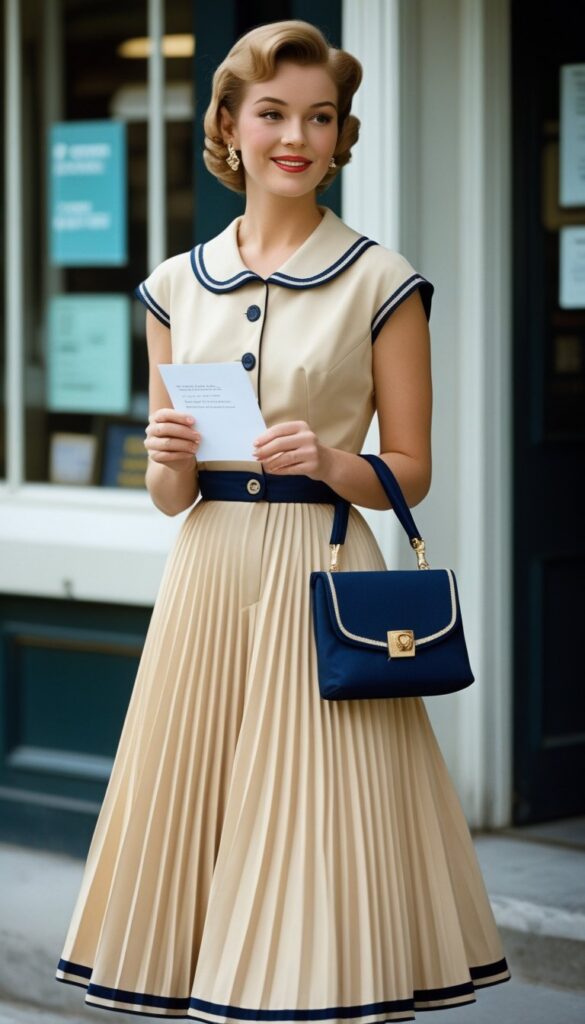
Day dresses with pleated skirts were easy to wear yet polished. Contrast trims on the sleeves, collar, or buttons added visual interest without disrupting the clean silhouette. These were commonly worn with small handbags and simple pumps.
Why it works:
The sharp pleats and trim accents give structure and detail, making it a go-to look for daily wear that still feels dressed up.
19. Lace Overlay Cocktail Dress
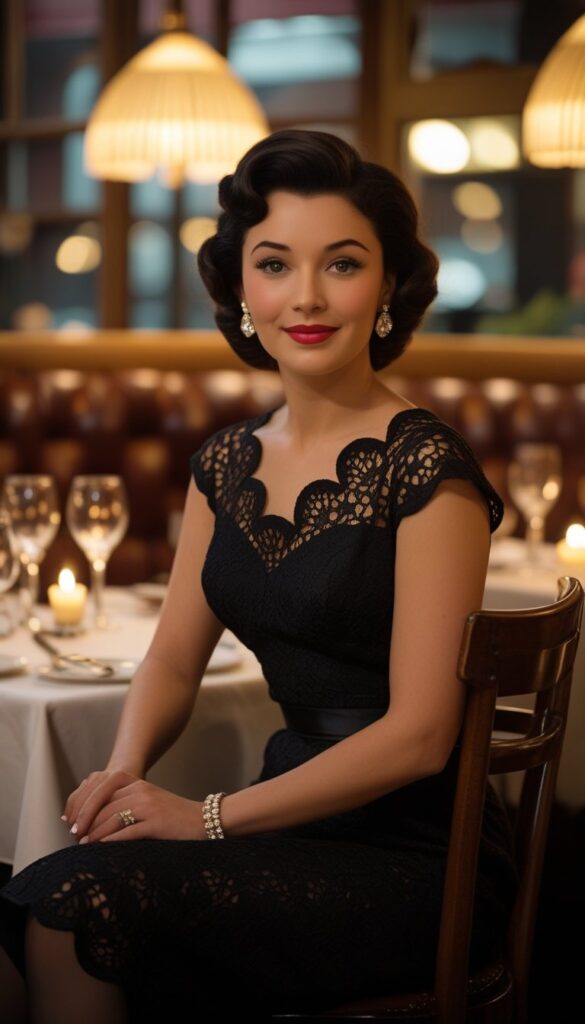
Cocktail dresses made of lace overlay were chic and feminine, often in shades like black, ivory, or blush. The fitted bodices and knee-length hems made them perfect for dinner parties. Accessories were minimal to let the texture stand out.
Why it works:
Lace brings elegance and texture, while the silhouette maintains the understated sophistication of the 1950s.
Also Read:1950s Men’s Fashion: 16 Classic Looks That Still Define Masculine Style
20. Cap Sleeve Dress with Button Front and A-line Skirt
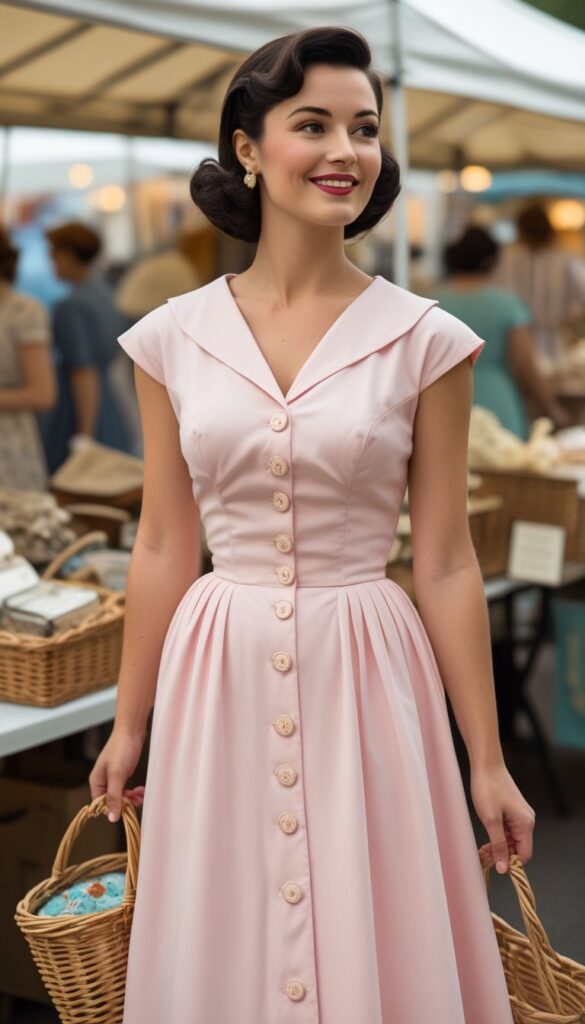
Cap sleeve dresses with button fronts blended the functionality of workwear with the grace of fashion. The A-line skirt gave it movement, and subtle prints or pastel shades made it easy to style for day-to-day outings.
Why it works:
It mixes utility with style, making it a practical choice that doesn’t sacrifice vintage flair.


